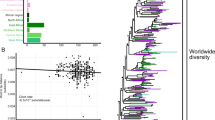Summary
Herpes simplex virus type 1 (HSV-1), a common human pathogen of non-epidemic nature is linked closely to the individual by latent infection. HSV-1 genotypes usually differ with race. Based on a “dual structure model” for population history of the Japanese, modern Japanese populations are assumed to have derived from two major migration events. The Jomon people arrived in Japan >10,000 years ago and the Yayoi people began migrating to Japan from the Korean peninsula ∼2,300 years ago. The presence of two predominant genotypes of F1 and F35 was noted in HSV-1 strains isolated in Japan. As the F1 genotype also predominated in Korea, peoples of Japan and Korea share the F1 genotype. Regional differences in the frequency of F1 and F35 genotypes within Japan seem to relate to differences in the dispersion of descendants of the Yayoi and Jomon peoples. Our hypothesis is that the F35 genotype relates to the Jomon people, earlier residents in Japan, while the F1 genotype relates to the Yayoi people who migrated much later from the Korean peninsula.
Similar content being viewed by others
Author information
Authors and Affiliations
Additional information
Received February 18, 1997 Accepted June 19, 1997
Rights and permissions
About this article
Cite this article
Umene, K., Sakaoka, H. Populations of two Eastern countries of Japan and Korea and with a related history share a predominant genotype of herpes simplex virus type 1. Arch. Virol. 142, 1953–1961 (1997). https://doi.org/10.1007/s007050050213
Published:
Issue Date:
DOI: https://doi.org/10.1007/s007050050213




